Team building ice breakers don’t have to be boring or cringey. They’re actually great fun when done right. Here’s the ultimate list of best ice breakers for team building. These easy to do ideas are creative, fun and engaging to help shake off any nerves and bring your team closer together. Are you ready to have some fun?
1. Scavenger Hunt
How It Works: Create a list of items or tasks for team members to find or complete within a set time frame, either in the office, outside or virtually.
Why It’s Good: It promotes teamwork and strategic thinking. It’s a fun way to break the routine. Your team can join in wherever they’re working.
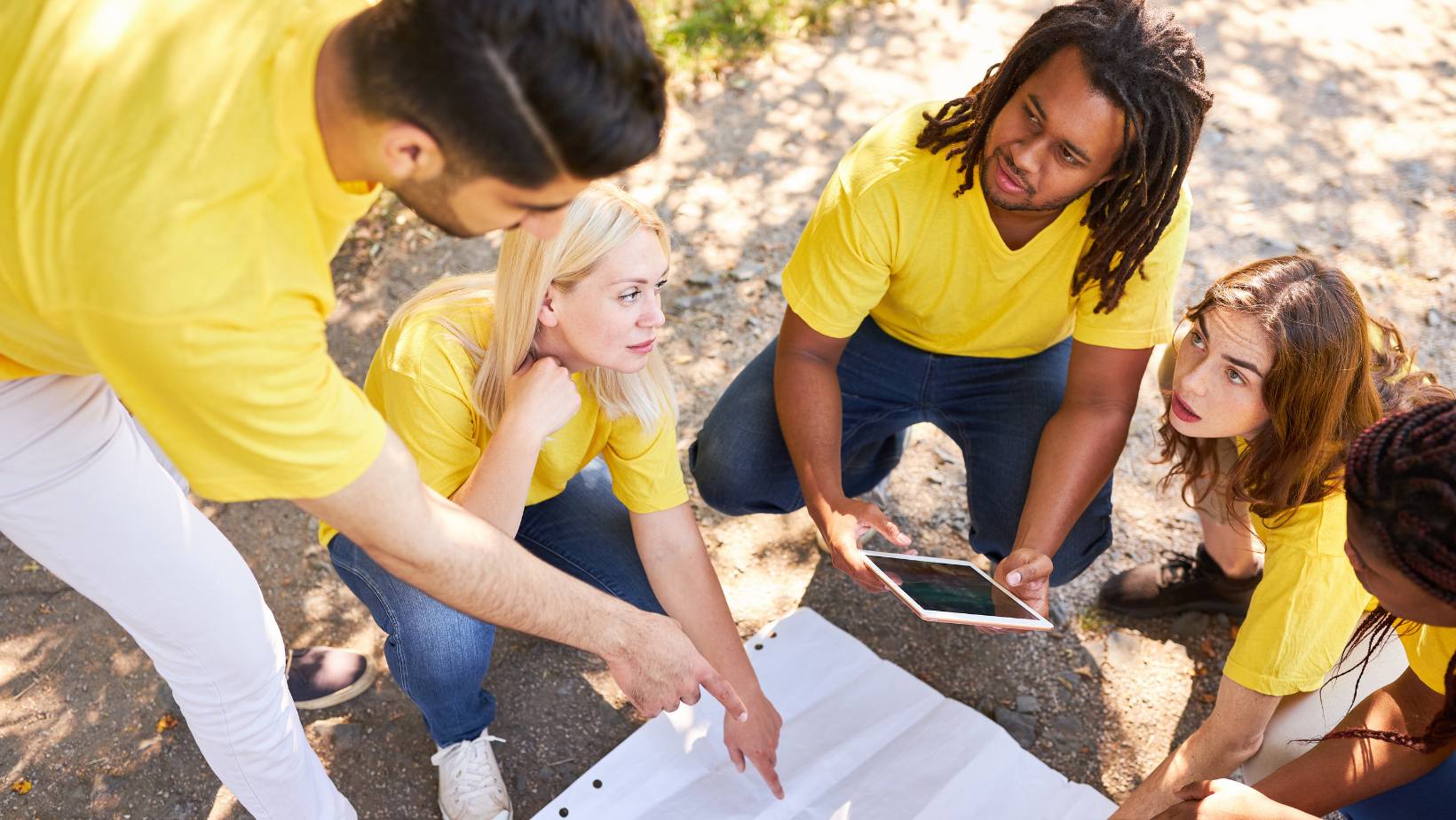
2. Quiz
How It Works: Prepare quiz questions about the office and team members. Quiz the group and see who knows the most. Split your group into teams or departments to add a competitive element.
Why It’s Good: It encourages people to pay attention to their surroundings and get to know their colleagues better in an informal setting.
3. Two Truths, One Lie
How It Works: Each person shares two truths and one lie about themselves. The rest of the team guesses which statement is the lie with sometimes surprising results.
Why It’s Good: This game encourages honesty and storytelling, helping team members learn surprising things about each other. It's always a good way to bring a bit of fun into the workplace.
4. Stranded on a Desert Island
How It Works: Ask your team, "If you were stranded on a desert island, what three items would you bring and why?" Each person then shares their list.
Why It’s Good: It encourages creative thinking and reveals team member's priorities and problem-solving skills. It's a great conversation starter as they compare their lists.
5. Human Knot
How It Works: Everyone stands in a circle and reaches across to holds hands with two different people. The group then works together to untangle the knot without letting go of hands.
Why It’s Good: It promotes teamwork, problem-solving and physical coordination, and can be hilarious!

6. Would You Rather?
How It Works: Ask your team a range of "Would you rather?" questions. For example, "Would you rather fight one horse-sized duck or 100 duck-sized horses?"
Why It’s Good: Would You Rather always sparks lively and fun discussions and help team members to understand each other’s preferences and personalities. This activity has a lot of flexible. You can tailor the questions to meet your team's personalities and get as wacky as you like.
7. The Marshmallow Challenge
How It Works: Teams are given sticks of dry, uncooked spaghetti, tape, string and a marshmallow. The goal is to build the tallest structure that can hold the marshmallow on top within a set time.
Why It’s Good: It encourages collaboration, innovation and engineering skills. It's a great chance for your team to work together, get competitive and show off a bit. This one’s really fun, whether you’re trying out team building in London or another location.
8. Show and Tell
How It Works: Each person brings an item or a few things from their desk or home that means something to them and explains why.
Why It’s Good: It builds personal connections and allows team members to share parts of their life outside of work. It's a brilliant way to get to know each other.
9. Pictionary
How it Works: Use an online Pictionary tool or a whiteboard. Team members take turns drawing something while the others guess the word or phrase.
Why It’s Good: It encourages creativity and quick thinking. Plus, it’s always good for a laugh. No drawing skills are needed. It's just about giving it your best go.

10. Speed Networking
How It Works: Set up short, timed sessions where pairs of employees chat and get to know each other better. Rotate until everyone has spoken with each other.
Why It’s Good: It builds connections quickly and can break down cliques within larger teams, helping people in different departments socialise with each other when they might not usually get the chance.
11. Story Starters
How It Works: One person starts a story with a single sentence. Each subsequent person adds another sentence to continue the story until it’s complete, going one by one.
Why It’s Good: It encourages creativity and collaboration, and can lead to some hilarious outcomes. It gives everyone a chance to shine.
12. Pet Parade
How It Works: For virtual teams, have a "parade" where everyone introduces their pets to the group on video call. Each person shares a fun fact about their pet. You could even try doing this in real life if you can find a pet-friendly venue.
Why It’s Good: This team ice breaker is light-hearted and fun. It gives a glimpse into colleagues' personal lives and adds a dose of cuteness to the workday. After all, who doesn't love pets?
13. Emoji Introductions
How It Works: Have each person in your team introduce themselves using five emojis that describe them best. The others can then guess the meanings or even assign emojis they think would work for that team member.
Why It’s Good: It's a modern, fun and quirky way to share personality traits and interests.
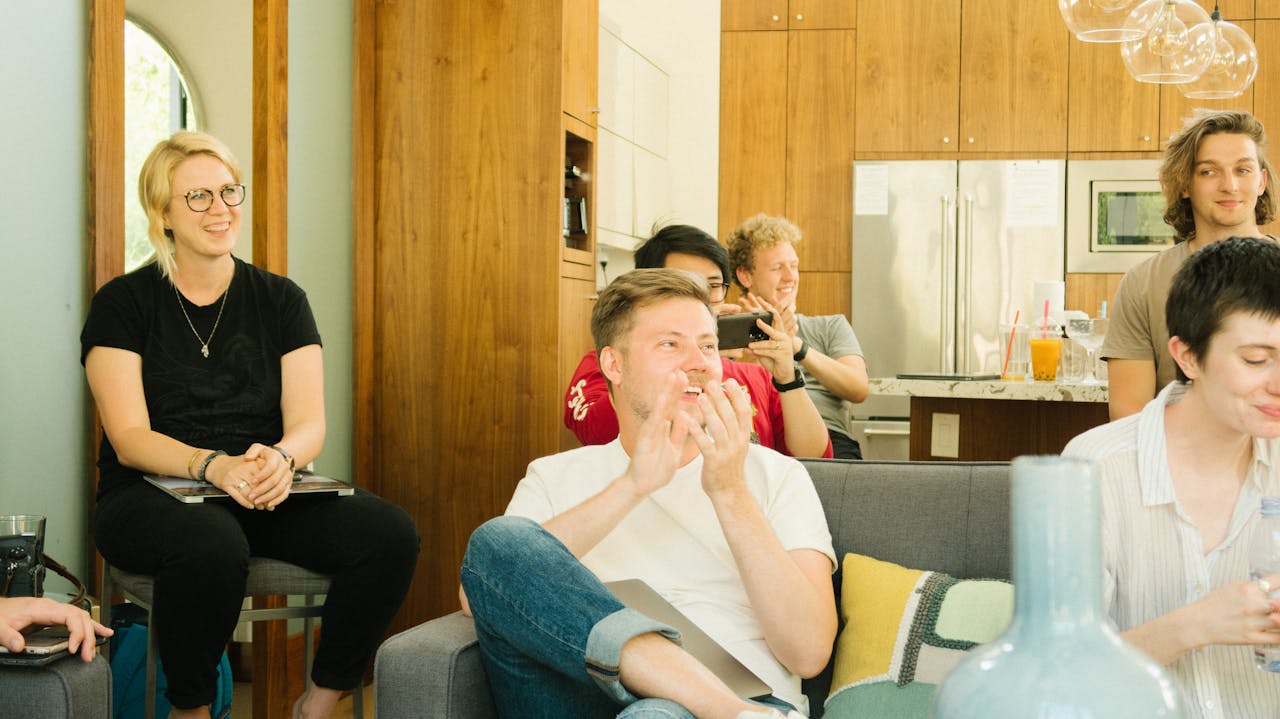
14. Name That Tune
How It Works: Play short clips of songs and have team members guess the song and artist. Use a mix of genres and eras to give everyone a chance to show off their knowledge.
Why It’s Good: It's great fun for music lovers and encourages quick thinking and memory recall.
15. Who Am I?
How It Works: Write out and tape a name of a famous person or character on each person’s back. They must ask yes/no questions to figure out who they are. For example, am I a woman? Am I an actor? Am I in my 50s? etc.
Why It’s Good: This team ice breaker game promotes interaction and is a fun way to break the ice.
16. Silent Line Up
How It Works: Without talking, team members must line up in order of their birthdays, height or another criteria. They must remain silent throughout the game until the correct answers are revealed.
Why It’s Good: It encourages non-verbal communication and teamwork. They'll also learn a bit about each other.
17. Virtual Background Competition
How It Works: For virtual teams, try having a competition for the most creative video call background. Everyone votes on the best one.
Why It’s Good: It adds fun to virtual meetings and showcases creativity. It's a great way to break the ice during a video call and can be tailored to match any theme, season, brand etc.

18. My Best Moment
How It Works: Each person in your team shares one of the best moments of their life for two minutes. It could be anything, such as personal achievements, work wins or travel experiences.
Why It’s Good: It helps team members to understand what’s important to each other and builds deeper connections.
19. Around the World
How It Works: Each person shares something interesting about their culture, country or a place they’ve visited or would love to visit. It doesn't matter if it's your hometown or somewhere further afield.
Why It’s Good: It promotes cultural awareness and allows team members to share personal experiences.
20. Ice Cream Break
How It Works: Schedule a short break where everyone can get their favourite ice cream and share why they chose that flavour.
Why It’s Good: This creates a relaxed and fun atmosphere and lets team members share a personal preference. It's also a great way to treat your staff and show a little appreciation for their work.
21. Animal Match
How It Works: Ask everyone in your group to think of an animal that they feel represents their personality and explain why.
Why It’s Good: It’s a light-hearted way to explore personality traits and see how team members view themselves. Plus, talking about cute animals always helps people to open up and feel comfortable.
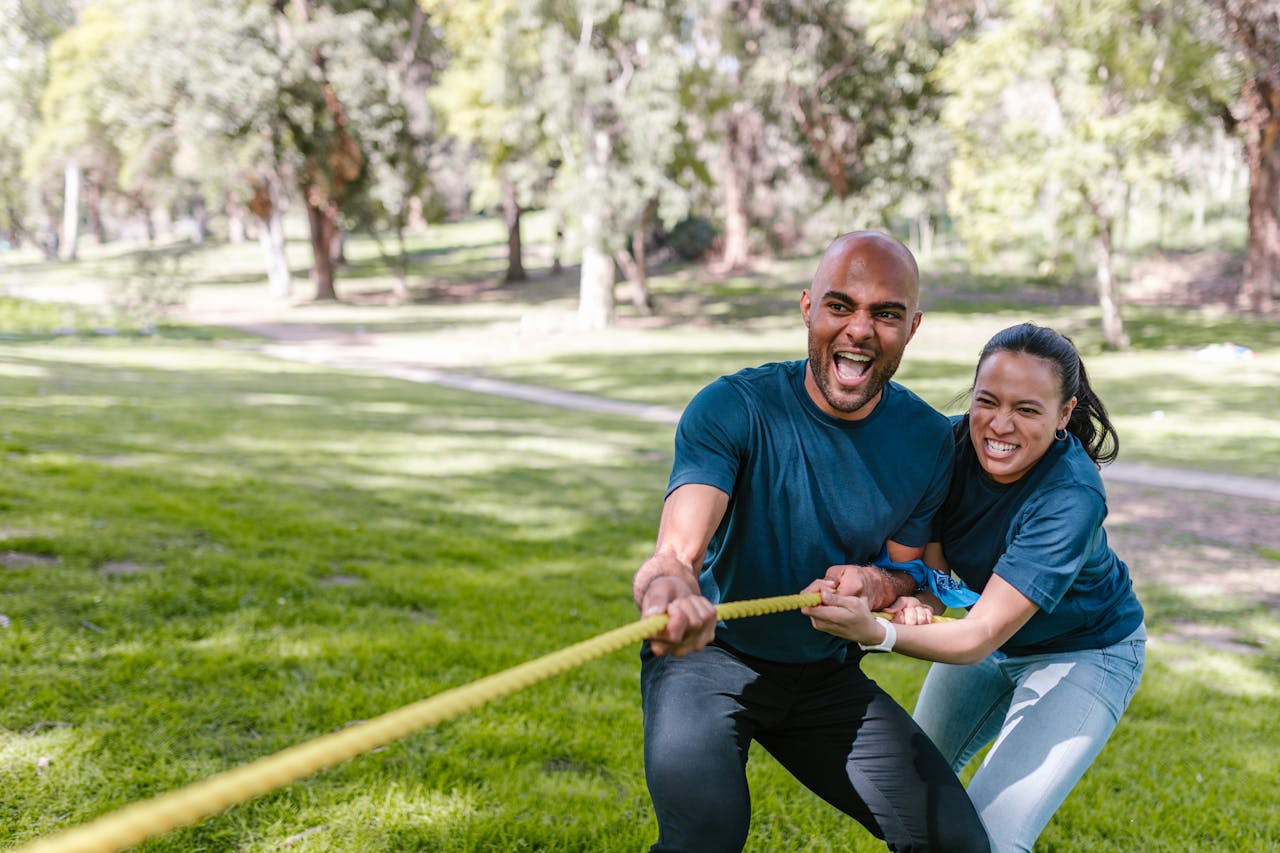
22. Workplace Awards
How It Works: Have a light-hearted awards ceremony where team members vote for winners in categories such as “Most Likely to Brighten Your Day,” "Best Lunch," "Most Helpful" or “Best Dressed.”
Why It’s Good: It's a good idea to recognise hard work and celebrate individual contributions in a fun way. You want your team to feel seen and valued.
23. Fancy Dress Day
How It Works: Choose a theme and have a fancy dress day where everyone comes in a costume. Have a mini fashion show where everyone shows off their outfits. Themes could include colours to match your brand, superheroes, Christmas, Halloween etc.
Why It’s Good: It encourages creativity and adds a fun twist to the workday. You can even get people to pick a winner who'll get a prize. Allow flexibility with the theme so that everyone can dress in something they feel comfy in.
24. Random Facts
How It Works: Each person shares a random fact about themselves that others might not know. For an extra layer of fun and mystery, you can write these down then pull them out of a hat one by one, allowing the rest of the team to guess who the fact belongs to.
Why It’s Good: It encourages sharing and learning new things about team members.
25. Bucket List
How It Works: Team members share one thing from their bucket list they hope to accomplish in their lifetime.
Why It’s Good: It reveals personal aspirations and dreams, fostering deeper connections. It allows each team member to share something they are comfortable with sharing.

26. Flash Mob Dance
How It Works: Split into a smaller group or department to learn a quick and simple dance routine and surprise another team with a flash mob.
Why It’s Good: It helps your group to work together, embrace spontaneity and just have some fun.
27. Office Art Gallery
How It Works: Everyone draws a picture related to a theme and shares it with the team. The theme could be something in the workplace, a holiday spot, something in your local town etc.
Why It’s Good: It encourages artistic expression and adds a personal touch to team interactions.
28. Guess Who
How It Works: Share an old photo of you from when you were a child. Keep who it is anonymous and let the rest of the team guess who they think it is.
Why It’s Good: It builds nostalgia and lets team members see a different side of each other. And we all love cute baby photos!
29. Mystery Bag
How It Works: Put random items in a bag. Each person pulls out an item and tells a story about it, real or made up. Then the rest of the team have to guess whether it's true or false.
Why It’s Good: It sparks creativity and is a great way to lighten the mood and get everyone talking.
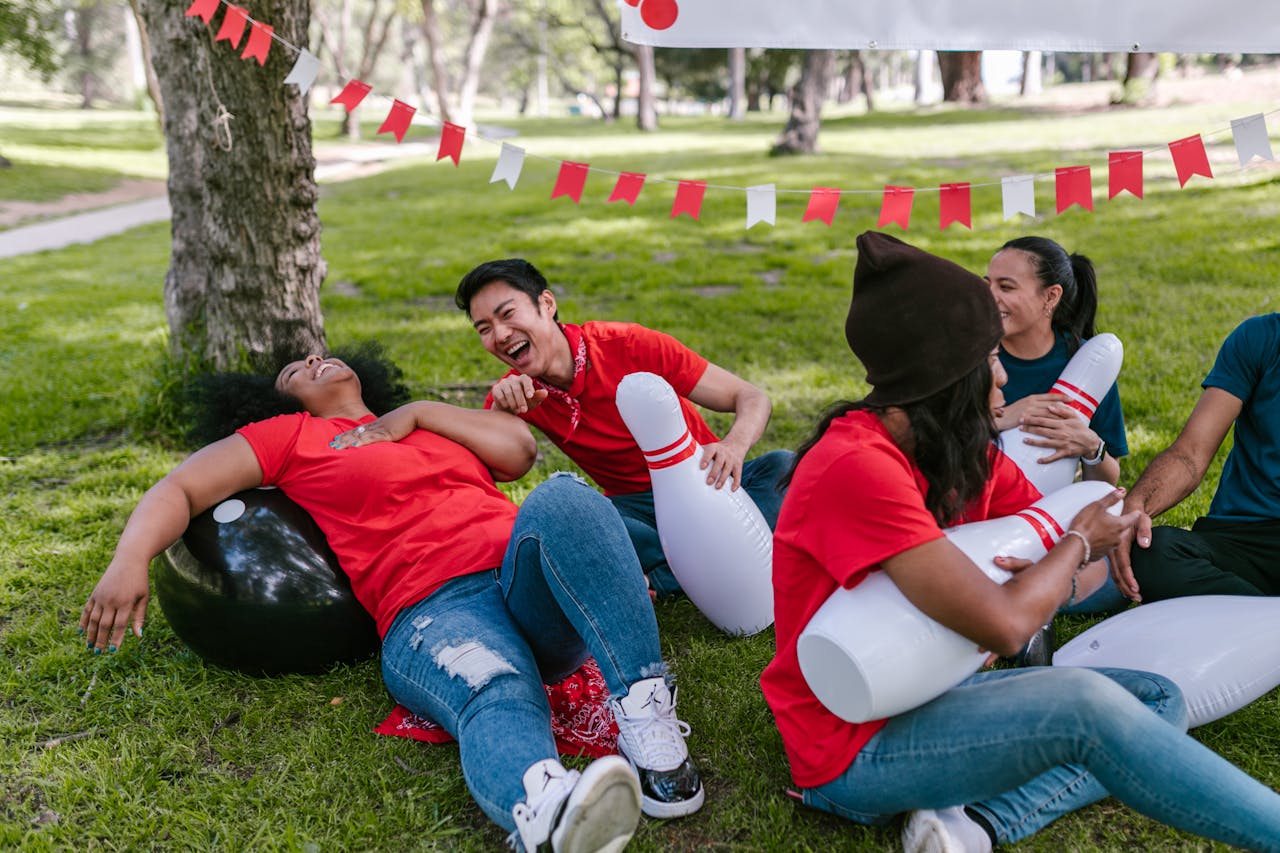
30. Improv
How It Works: Act out a random scenario that's given to you. Alternatively, you could try improv games like “Yes, And...” where each person adds to a story with “Yes, and...” to build an ongoing narrative.
Why It’s Good: It boosts creativity, quick thinking and collaboration.
31. Time Capsule
How It Works: Get each team member to write down something they hope to achieve within the next year. Collect these and put them in a "time capsule" to be opened a year later.
Why It’s Good: It encourages goal setting and gives the team something to look forward to in the future. They feel accomplished and proud when they open them the year after.
32. Team Talent Show
How It Works: Each person gets a few minutes to showcase a unique talent or skill, whether it's juggling, playing an instrument, singing, dancing or doing impressions.
Why It’s Good: It highlights hidden talents and provides a fun, engaging way to learn more about colleagues. Keep the atmosphere light and encourage team members to cheer each other on. You might even discover a hidden talent!
33. Alphabet Story
How It Works: Start with a word beginning with the letter A and each subsequent person adds a word starting with the next letter of the alphabet to build a story.
Why It’s Good: It promotes quick thinking and collaboration, often resulting in hilarious and unexpected stories.

34. Snapshot Memories
How It Works: Ask team members to share a photo from their phone that has a memorable story behind it. Each person explains why it’s meaningful.
Why It’s Good: It makes interactions more personal and fosters deeper understanding and connections. It also allows for flexibility as the staff member can choose which photo they're comfortable sharing with the group.
35. Movie Pitch
How It Works: Each person or group comes up with a pitch for a movie they'd like to create. Include the plot, main characters and why it would be a huge box office hit.
Why It’s Good: It encourages creativity, helps with public speaking and will often lead to entertaining and imaginative ideas. You can either ask your group members to do this alone or, to help improve teamwork and boost morale, they can do it in groups.
36. Work Playlist
How It Works: Create a playlist for the office or workplace as a group, where each team member adds a few of their favourite songs. Play it during breaks or team lunches.
Why It’s Good: Music is a great way to bond and it gives insight into everyone’s tastes and personalities. It's a fun, collaborative experience and makes sure that everyone plays their part.
37. Early Years Dream Job
How It Works: What did you want to be when you grew up? Ask team members to share their dream job from childhood and why they chose it. This can be realistic or completely fantastical.
Why It’s Good: It encourages sharing personal aspirations and can lead to interesting discussions about career goals and passions. And everyone loves a dollop of nostalgia!

38. Mystery Lunch Partner
How It Works: Randomly pair team members to have lunch together. They'll get to know each other better over a meal. Try to break up friendship groups and departments so pair people up who don't know each other as well.
Why It’s Good: This free ice breaker for teams breaks down workplace cliques and encourages team members to build relationships with colleagues they might not usually interact with, leading to the wider team being closer.
39. Reverse Q&A
How It Works: Instead of asking questions to others, each person shares something about themselves and the rest of the team guesses questions that match the information.
Why It’s Good: It offers a unique twist on traditional introductions and encourages thoughtful engagement. You can also add a competitive element if you fancy it.
40. Word Association
How It Works: Start with a random word, and each person says the first word that comes to mind in response. Continue the chain around the room.
Why It’s Good: This quick-thinking ice breaking game encourages mental agility and can lead to unexpected and funny results. If you’re looking for a warm up for team building in Brighton or a different city in the UK or Europe, this is a great option to get everyone chatting.
41. Balloon Burst
How It Works: Each person ties a balloon to their ankle with a string. The objective is to pop others’ balloons while protecting your own. The last person with an un-popped balloon wins.
Why It’s Good: This high-energy game is great for blowing off some steam and building competitive spirit in a fun way. It encourages agility and strategic thinking. Not to mention, helping everyone get a little bit of exercise.

42. Capture the Flag
How It Works: Divide your group into two teams, each with a flag hidden in their territory. The objective is to capture the opposing team’s flag and bring it back to your own territory without getting tagged.
Why It’s Good: This game promotes strategic thinking, teamwork, and physical activity. It’s exciting and encourages players to work together to achieve a common goal.
43. Tower Building
How It Works: Provide teams with materials like straws, tape and paper clips. The challenge is to build the tallest tower within a set time limit. The tower must be able to stand on its own without any support.
Why It’s Good: Tower building encourages creativity, engineering skills and collaborative problem-solving. Plus, it’s a great way to see how team members tackle challenges under pressure.
44. Simon Says
How It Works: One person plays Simon and gives commands like “Simon says touch your toes.” Everyone must follow the commands only if they start with “Simon says.” If Simon doesn’t say, those who follow are out.
Why It’s Good: This classic game sharpens listening skills, encourages quick reactions and is a fun way to get everyone moving.
45. Egg Drop Challenge
How It Works: Provide materials like straws, tape, paper and rubber bands. Teams must then make a contraption or structure that'll protect an egg from breaking when dropped from a height.
Why It’s Good: This is a classic team ice breaker, promoting engineering skills, teamwork and creative problem-solving. It’s also a lot of fun to see which designs work and which don’t, leading to the egg breaking.

46. Three Legged Race
How It Works: Pair up team members and tie their adjacent legs together. They must race to the finish line without falling over.
Why It’s Good: This classic PE activity encourages cooperation, coordination and trust between the two partners. It’s a great way to build bonds and get everyone laughing.
47. Group Juggle
How It Works: Get your team to make a circle and start with one ball. The aim of the game is to pass the ball to someone who hasn’t touched it yet, saying their name first. Gradually add more balls into the mix to make things more fun.
Why It’s Good: It enhances coordination, communication and the ability to work well under pressure. Plus, it’s great for learning and remembering names.
48. Memory Recall
How It Works: Get each person share a memorable event from the past week or month. Others can ask questions about the event if your group feels comfortable.
Why It’s Good: It encourages sharing recent experiences and can help the team stay updated on each other’s lives and wins.
49. Dream Holiday
How It Works: Each team member describes their ideal holiday destination, why they want to visit and what they would do there.
Why It’s Good: This activity sparks conversations about travel preferences and personal interests, helping team members find common ground.
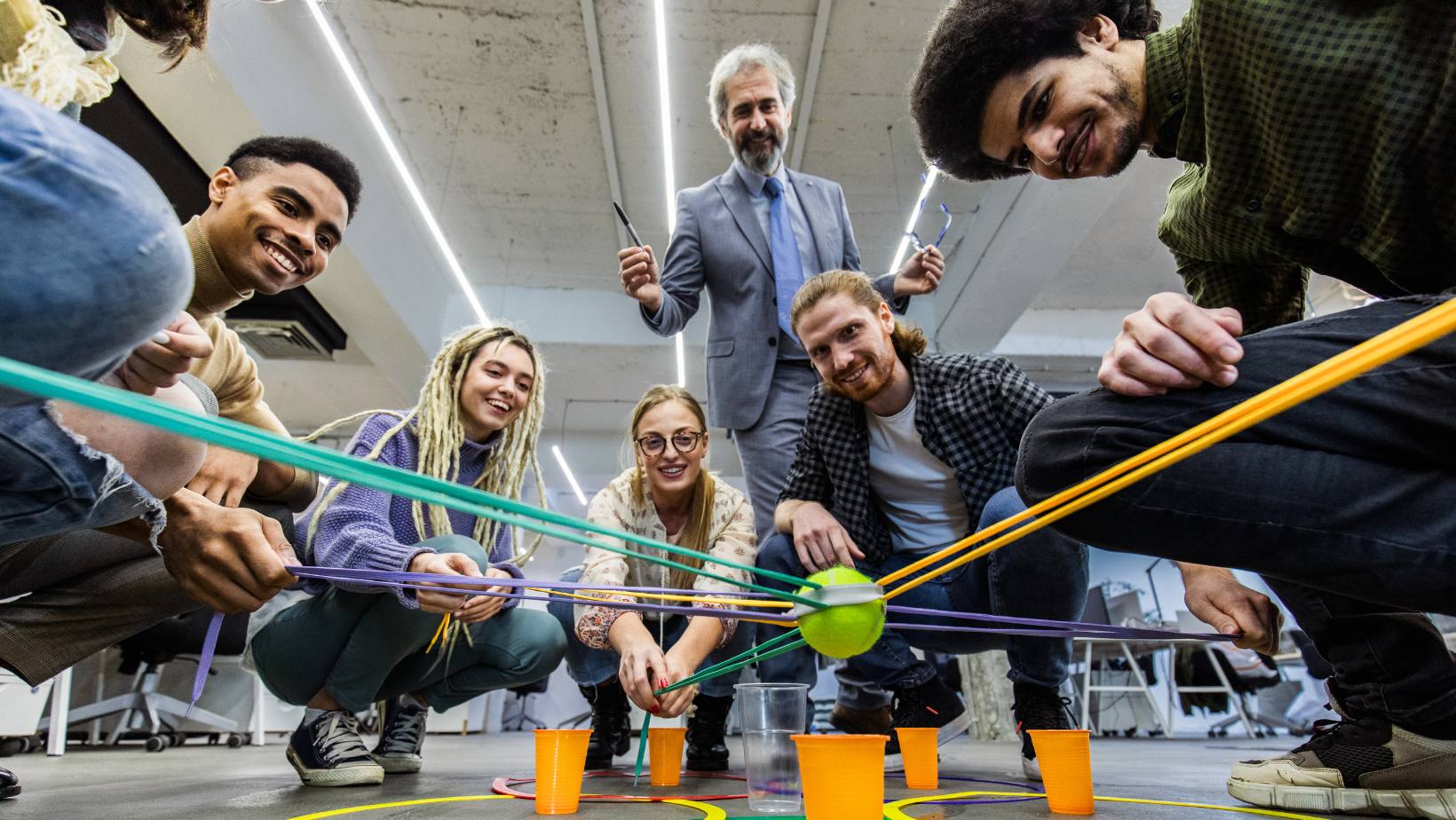
50. Name That Sound
How It Works: Play short audio clips of everyday sounds (like a door creaking, a dog barking or a phone ringing) and have team members guess what they are. You can make them as obscure or obvious as you like.
Why It’s Good: It's fun and challenging, testing everyone's listening skills and can lead to some funny guesses.
51. Rapid Fire Questions
How It Works: Prepare a list of rapid-fire questions (for example; Coffee or tea? Cats or dogs? Early to bed or night owl?). Ask each person a series of quick questions and have them answer as fast as possible.
Why It’s Good: This fast-paced activity is great fun, helping team members learn fun facts about each other and breaking the ice quickly.
52. Haiku Happiness
How It Works: Each person writes a haiku (a three-line poem with a 5-7-5 syllable structure) about their job, their day, something they enjoy or a topic of their choice.
Why It’s Good: It encourages creativity and offers a fun way to express thoughts and feelings in a structured format. It's also likely to bring back school memories.
53. What's In Your Bag?
How It Works: Ask each person to pull out an item from their bag or pocket and share why it’s there or what it means to them.
Why It’s Good: It's personal and often surprising, revealing everyday essentials and personal quirks.

54. Survivor Scenario
How It Works: Present a survival scenario (for example, being stranded on a mountain, at sea etc) and a list of items. Teams must choose which items to prioritise for survival and explain their choices.
Why It’s Good: It encourages teamwork, problem-solving, imagination and strategic thinking as well as revealing a bit about different people in your group.
55. Superpower Wish
How It Works: Each team member shares what superpower they would choose and why. Follow up with a discussion about how they might use it in their daily lives and in their job.
Why It’s Good: This imaginative exercise helps you to understand personal desires and values. What would you choose?
56. One Word Pulse Check
How It Works: Ask each person to describe their current mood or state of mind in one word. Go around the room and let everyone share.
Why It’s Good: It provides a quick insight into how everyone is feeling and sets the tone for the meeting or day ahead.
57. Human Bingo
How It Works: Create bingo cards with different activities or traits (for example, has run a marathon, can play an instrument, loves sushi etc). Team members must then find colleagues who match each trait and have them sign their bingo card. The first to get bingo wins.
Why It’s Good: This game promotes interaction, encourages team members to learn more about each other and gets everyone moving around.

58. Obstacle Course
How It Works: Set up a simple obstacle course using office furniture, chairs, desks or outdoor equipment. Teams will then compete to navigate the course in the fastest time. Add challenges like crawling under desks, hopping on one foot or carrying an item.
Why It’s Good: It promotes physical activity, teamwork and problem-solving. It’s also a fun way to break the routine and bring some excitement to the day. Just be sure to adhere to health and safety rules.
59. Paper Aeroplane Competition
How It Works: Provide paper and have each team member create a paper aeroplane. Mark a starting line and see whose plane flies the furthest distance. You can also have categories for the most creative design and best looking.
Why It’s Good: Encourages creativity and a bit of friendly competition. It’s a simple and affordable team building ice breaker, yet a very fun activity that can be done indoors or outdoors.
60. Pass the Hula Hoop
How it Works: Form a circle and hold hands. Place a hula hoop on one person's arm. The goal is to pass the hula hoop all the way around the circle without letting go of hands.
Why It’s Good: This activity helps to improve your teamwork, coordination and problem-solving as team members work together to move the hula hoop around the circle.
The Benefits of Team Building Ice Breakers
Team building icebreakers are fantastic for easing social tension. Think back to the first day at a new job or meeting new teammates and how awkward and nervous you might’ve felt. Ice breakers break down those barriers fast, They create a relaxed environment where everyone feels more comfortable, leading to better communication. When people are at ease, they’re more likely to share ideas, ask questions and collaborate well.

Ice breakers can spark imagination and innovation. These activities encourage out-of-the-box thinking. Suddenly, the quietest person in the room might come up with the most brilliant solution. By engaging in playful, creative exercises, team members learn to approach problems from new angles. They also build trust. When team members take part in activities that require them to share personal anecdotes or work together to complete a task, they build rapport and trust. Trust is the foundation of any successful team and with it, they’re more able to work well together.
Don’t forget about the fun factor. We all know that work can be stressful, with looming deadlines and pressure. Ice breakers inject a much-needed dose of fun into the workday. Laughter and shared positive experiences are great for bonding. When people enjoy each other’s company, they’re more likely to support one another and work well together. Plus, a fun work environment is a huge morale booster. Happy employees are more engaged and productive.
Another underrated benefit of ice breakers is that they highlight individual strengths and talents. Maybe someone in the team has an uncanny ability to think on their feet or another has a talent for storytelling. Ice breakers reveal these hidden skills and can help managers and team leaders leverage them effectively.
Ice breakers can set the tone for the company culture. A workplace that values team building and incorporates fun activities into the routine shows that it cares about employee well-being. It sends a message that the organisation values not just what you do, but how you do it. This can be motivating for employees. Team building ice breakers are much more than a way to kill time before a meeting. They’re a powerful tool for enhancing communication, sparking creativity, building trust and injecting fun into the workplace. So, what are you waiting for? Break the ice today!






